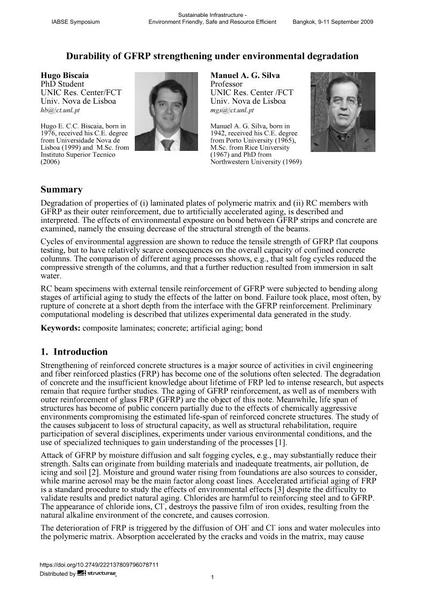Durability of GFRP strengthening under environmental degradation

|
|
|||||||||||
Bibliographic Details
| Author(s): |
Hugo Biscaia
Manuel A. G. Silva |
||||
|---|---|---|---|---|---|
| Medium: | conference paper | ||||
| Language(s): | English | ||||
| Conference: | IABSE Symposium: Sustainable Infrastructure - Environment Friendly, Safe and Resource Efficient, Bangkok, Thailand, 9-11 September 2009 | ||||
| Published in: | IABSE Symposium Bangkok 2009 | ||||
|
|||||
| Page(s): | 64-71 | ||||
| Total no. of pages: | 8 | ||||
| Year: | 2009 | ||||
| DOI: | 10.2749/222137809796078711 | ||||
| Abstract: |
Degradation of properties of (i) laminated plates of polymeric matrix and (ii) RC members with GFRP as their outer reinforcement, due to artificially accelerated aging, is described and interpreted. The effects of environmental exposure on bond between GFRP strips and concrete are examined, namely the ensuing decrease of the structural strength of the beams. Cycles of environmental aggression are shown to reduce the tensile strength of GFRP flat coupons testing, but to have relatively scarce consequences on the overall capacity of confined concrete columns. The comparison of different aging processes shows, e.g., that salt fog cycles reduced the compressive strength of the columns, and that a further reduction resulted from immersion in salt water. RC beam specimens with external tensile reinforcement of GFRP were subjected to bending along stages of artificial aging to study the effects of the latter on bond. Failure took place, most often, by rupture of concrete at a short depth from the interface with the GFRP reinforcement. Preliminary computational modeling is described that utilizes experimental data generated in the study. |
||||
| Keywords: |
concrete bond composite laminates artificial aging
|
||||
